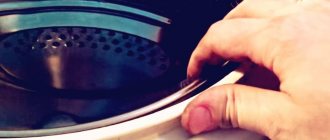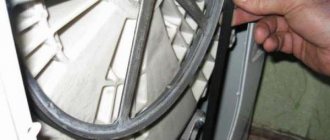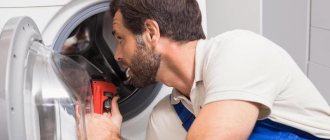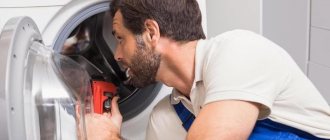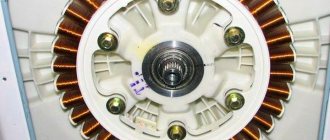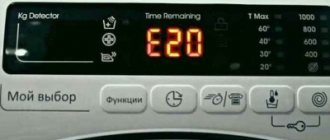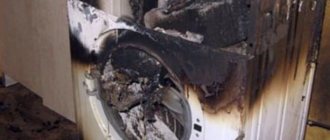Published: 14 Oct 2020
Although advertising promises with all its might that the washing machine operates silently, in reality this is not the case. SMA is a complex household appliance, some of its parts move and rotate, and therefore make noise. This is the sound of normal operation, but sometimes owners notice that something is knocking loudly inside the washing machine. It can rattle in different ways:
- a knocking sound appears during washing or is heard during the spin cycle of the washing machine;
- The knocking sound in the washing machine is heard only in the spin mode.
What to do if you hear unusual knocking sounds? First you need to exclude external causes.
Noise Level Standards
The noise level of a washing machine of a certain model is specified in its instructions. It depends on what the drive is:
- in the belt version, its variations are from 60 to 72 dB (decibels);
- with the direct drive option, the threshold is reduced - from 52 to 70 dB.
What do these numbers say? The fact is that the user will still hear the operation of such a device, and absolutely silent washing machines do not exist. The technique works, but such audibility should not create discomfort. If such a feeling occurs, the device is clearly not working. And it’s good if the reasons turn out to be not very serious.
When it's not about breakdown
To figure out why the Indesit washing machine knocks and jumps during the spin cycle, you will have to diagnose the system. There are several factors that can lead to this. It is better to start with reasons that do not mean that there is any breakdown.
Uneven distribution of laundry in the drum cavity. Loaded clothes during the washing process sometimes gather into one solid lump and hit the walls of the tank. This leads to imbalance. In such a situation, dealing with the knocking is very simple: pause the running program, wait for the hatch door to unlock, and distribute the items evenly over the surface of the drum.
Modern models of the Indesit line have a built-in imbalance control function, so such a problem should not arise.
The washing machine is standing on an uneven surface. Very often, the cause of unpleasant noise lies precisely in the incorrect installation of the machine . By changing the position of the unit, you can cope with the knocking noise.
To determine whether the machine is actually positioned incorrectly, you need to take a building level and check whether the body is level. If there is no such device, just try to rock the washing machine. When the device is positioned according to all the rules, it does not move. If an incorrect position is detected, to solve the problem it is better to buy special stands and place them under the body, aligning the MCA.
Manifestations of unnatural noise
The quiet measured noise of a moving drum and a running motor occurs during washing in any model of machine such as a centrifuge. First, you should pay attention to the nature of the sound, which may indicate a malfunction:
- the sound is unnatural, it increases with each wash;
- The washing machine is especially noisy during the spin cycle;
- pronounced extraneous noise, similar to clanging, grinding or hitting.
Of course, the first thing that might come to the owner’s mind when faced with such a common phenomenon in a washing machine is that it’s just a sound due to the metal parts of the clothes themselves. But when you wash bed linen or towels, and the noise gets louder, it’s time to think about a malfunction.
Why is the sound of the washing machine heard most during the spin cycle? The fact is that at this stage of operation the centrifuge drum rotates the strongest and fastest.
This serves as a good test for all mechanisms. Accordingly, with the increase in the roar of the engine, noise during breakdowns will be more noticeable, since rapid movement rocks all other parts, including the body.
When spinning, the drum knocks loudly: what can you do yourself?
When the washing machine is operating in spin mode, the rotation of the drum reaches its highest speeds.
Noise and vibration inevitably occur. In some cases, such as improper installation or malfunction of certain parts, it may shake and make more noise than expected. It is not recommended to try to repair serious faults at home, as this risks damaging fasteners, the tank cross and other parts. However, if you notice excessive noise or shaking during washing, follow these steps:
- Switch the machine to spin mode and after it has drained the water, open the drum and remove some of the laundry. Then turn it on again. If the knocking and vibration stop, then the problem was overload.
- Start the unit at idle speed, then turn on the spin program. If the centrifuge continues to rattle, then the problem is most likely a malfunction of the internal mechanisms.
- Bend the hatch cuff and inspect the space between the tank and the drum. If there is a foreign object there, try to remove it.
- Open the filter hole by first inserting the tray. Clean it of small debris.
Has your washing machine started making an uncharacteristic knocking noise? This happens sometimes.
And this is not always a sign of a unit malfunction. Perhaps it is metal or large plastic parts of the laundry (buttons, zip runners, carabiners) knocking against the glass of the hatch and the drum. It is recommended to wash items with large fittings inside out or in special washing bags: this way there will be no knocking or damage to the machine.
If you loaded only soft clothes, and the knocking sound is clearly heard, then there is definitely a problem with the washing machine. Sounds uncharacteristic of washing occur due to a number of malfunctions. Only a specialist can correctly diagnose them, sometimes only with special equipment. But based on some signs, you can figure out on your own what happened to the assistant.
Attention! Before performing maintenance, disconnect the machine from the power supply and water supply!
Why does the washing machine hum when washing?
There are many reasons. Extraneous sounds appear from mechanical wear and breakdown of mechanisms, malfunctions of the control module, etc.
Loud noises are also a consequence of violation of the rules of technical operation of the unit.
Due to improper use
- Constant overload of laundry leads to wear and destruction of bearings. It manifests itself as a loud hum and grinding noise.
- The drain filter is clogged. The pump makes a loud noise.
- No water softener is used. Lime deposits form inside hoses and pipes. It manifests itself as a loud hissing sound when filling and draining water.
Foreign object getting inside
Sometimes, when operating the machine, small objects fall out through the holes in the centrifuge into the space between it and the outer tank, for example, a bra wire, a button, or a small item that might have fallen out of your pockets. In this case, in order to remove a foreign object, if it cannot be reached through the door cuff, the device will have to be disassembled. To get to the space where the thermal electric heaters are located, depending on the model, it is necessary to remove the rear or front panel of the unit.
Uneven distribution of things
This problem is typical for older machines. In them, when washing and spinning, things do not straighten out, but clump together. In order for the centrifuge to stop knocking, when loading laundry, you need to lay it out evenly, without overloading the drum. It is also advisable to wash bedding and clothing separately.
Incorrect installation of the washing machine
If errors were made during the installation of equipment, then in accelerated operation this is especially noticeable. In this case, it is necessary to check the correct location of the unit and make the necessary adjustments. In order to determine whether the car is level, you can use a level. If distortions are detected, it can be moved to a more even surface. In some models, the position can also be adjusted using screw-in and screw-out legs.
Advice! Do not place the washing machine close to a wall or furniture. There should be a small space between them.
The hatch seal does not fit
An incorrectly installed rubber cuff of the hatch causes extraneous sounds caused by friction against the edge of the rotating drum. The washing machine whistles, creaks, whistles with a characteristic “rubber” timbre.
The spring burst
In most washing machine models, special springs are installed under the drum, which promote a softer unwinding of the tank. Sometimes such a spring breaks, causing the drum to tilt to one side and hit the structure. The same signs may indicate that the shock absorber in the device is broken.
To accurately determine the cause of the knocking noise when spinning things, you will have to completely disassemble the machine. Some people do this on their own, but it is better to seek help from specialists who professionally repair broken household appliances.
Knocking due to broken parts
If the machine is installed correctly, there are no foreign objects in it, and the laundry is distributed evenly, then the reason for the knocking sound is the breakdown of some part. It could be:
- broken spring;
- bearing failure;
- shock absorber failure;
- network filter defect;
- problem with the counterweight.
All problems related to breakdowns require sending the equipment to a service center.
Spring breakage
If the spring breaks, the drum may tilt to one side. However, it can look exactly the same if the shock absorber breaks down. To accurately identify the cause, it is necessary to disassemble the machine. This is done at the service center, and if there is a faulty spring, it is replaced. If you ignore the problem, then when washing the drum will poorly center the laundry and constantly sway.
During operation, springs experience heavy loads, so the main reason for their failure is long-term and intensive use.
Bearing failure
Like any moving parts, bearings wear out over time. They come out faster if the machine is not used correctly, for example, if it is not level and vibrates strongly. The second factor is time. The older the device, the noisier the bearings are.
You can replace them yourself, armed with instructions for a specific machine model.
Replacing the SMA bearing
Shock absorber failure
A broken shock absorber has very similar symptoms to a broken spring:
- the drum “sags” to one side;
- The washing machine cannot center the laundry correctly;
- there is a permanent imbalance.
In addition to the shock absorber, the mount may break, or the mounting bolt may simply become loose. It is possible to determine why the extraneous sound occurs only after disassembly. It is recommended to first carry out diagnostics by calling a specialist. After identifying a malfunction, the shock absorbers are replaced with new ones.
Line filter defect
To ensure that the machines serve for a long time and safely, they are equipped with surge protectors. Filters smooth out power surges. More often, such a block is mounted at the back of the machine under the cover. During operation, it can fly off the mount and rattle from the vibrations of the machine.
Surge filter in a washing machine
To solve this problem, you need to get to the filter and screw it into place, making sure that all other connections to it are in order.
Counterweight
The tank itself is quite light and to weigh it down, counterweights are used in its upper and lower parts. Thanks to this design, the risk of rocking during washing is reduced. However, over time, the counterweight can cause problems for you: loosening and knocking loudly when spinning. This problem can be fixed quite easily:
- the machine must be disassembled;
- determine which of the two counterweights is loose;
- tighten the fastening.
If the counterweight is not tightened in time, it may fly off or break. At the same time, the washing machine begins to knock during the spin cycle: at high speeds, the drum begins to touch the walls.
It is worth repairing such equipment as quickly as possible, before the faulty drum breaks all the insides of the household appliance.
How to properly diagnose a machine
In order to identify a malfunction in a timely manner, you need to familiarize yourself with the features of diagnosing the washing machine.
This is done after familiarizing yourself with the main reasons for the appearance of extraneous sounds during spinning.
During the diagnostic process, you will have to check how level the structure is installed. You will also have to disassemble it to check the serviceability of the parts and make sure that there is no debris or other large objects inside the drum that could knock.
The counterweight has weakened
This is the part that makes the washing machine stable. It is a concrete block, which in most cases is attached to the underside of the tank. Thanks to the counterweight, during the spin cycle or at the moment when the device picks up speed, the machine remains in its place. During operation, the fasteners holding the counterweight become very loose. As a result, it hits the drum. Solving this problem is not that difficult. What do we have to do? It is enough to disassemble the washing machine and tighten the fastenings. If the counterweight fails, it can be easily replaced.
What to do to troubleshoot
Some breakdowns can be fixed with your own hands. But if repairs cause you difficulties or the equipment is under warranty, it is better to contact a service center. How to make your own repairs, read below.
Transport bolts
In models of any brand (Indesit, Ariston, Samsung), the mounting bolts are located at the rear. Simply turn the washer over to the back panel and unscrew the screws as shown in the picture.
Correct installation
It is important to position and install the machine correctly to avoid unnecessary vibrations. To do this, follow these basic recommendations:
- Prepare a stable base. The floor under the equipment must be level and durable. If this is not the case, then you can prepare a concrete base or podium yourself.
- Align the housing strictly level. The feet will help you adjust the installation. Tighten them to adjust the height of the MCA.
If, after fulfilling the requirements, the machine continues to hum and vibrate, use special pads. Read about the right choice in the article “Anti-vibration stands for a washing machine. We choose and compare.”
Solutions to the problem
In addition to the situations listed, there are others that cause the washing machine to knock. If you did not check the pockets before washing, then various small items may well get into the interior of the device and rattle during operation. The problem can be easily resolved:
- remove the front or back panel;
- unscrew the heating element;
- we take out large garbage;
- we put everything back together in reverse order.
Another reason for sharp sounds during spin cycles is worn bearings. With such a malfunction, a squeaking sound is heard from the washing machine. In this case, the bearings must be replaced with new ones. If the washing machine squeaks but there is no knocking noise, you can try lubricating all the bearings.
If your washing machine drum is knocking when spinning, then it is better to take care of repairs as quickly as possible, or at least avoid working at high speeds, then the machine will last much longer.
After identifying faults, some of them can be fixed with your own hands, but for more complex ones you will need to disassemble the machine. How to fix the most common breakdowns?
If foreign objects get inside the machine, you will most likely have to disassemble it. To do this, you need to open the lid, remove the electric heating element and remove these things from the tank. In the event that it is impossible to reach foreign objects, you will have to completely remove the tank.
Replacing bearings is an inexpensive but rather complex repair. If they are not replaced, they may break the spider. To replace the bearings, the machine is completely disassembled and the tank is removed. The bearings are removed from their mounting points and replaced with new ones.
The transportation bolts must be removed before installing the machine in place - this will eliminate one of the causes of noise during operation.
Shock absorbers are not repaired, but replaced. To replace the dampers, you need to remove the rear cover of the car, unscrew the fasteners located below the shock absorber tank, remove them and install new ones. Then carry out all the steps in reverse order.
If the balance of the axle is disturbed, then it is necessary to tighten the nut on the pulley. In case of problems with the counterweight, it is necessary to remove the back or front panel (depending on the design of the device) and tighten all loose fasteners. If one of the weights breaks, and such cases are very rare, you need to replace it with a new one.
Leveling the machine is very easy. To do this, it must be installed on a flat floor, and by rotating the legs with a special key, we make sure that it does not swing.
Fault prevention
So, the causes of noise in a washing machine are varied. But all users can prevent many of these defects, or at least make them less common. The most important rule here is not to overload the device. It is also worth considering that washing several times in a row without a break for at least 1-2 hours contributes to wear and tear on the machine. There will be less extraneous sounds if you use washing at high temperatures only when there is a real need for it.
By cleaning the filter and pipelines, they help remove foreign matter from the drum when draining the water. By wiping the cuff after each wash, you prevent it from coming apart and touching the drum. It is also very important to use soft water.
If this is not possible, the use of softeners helps slow down the accumulation of scale on the heating element.
There are a few more recommendations:
- wash all items containing metal elements only in closed bags;
- periodically rinse the drain filter;
- ventilate the drum after finishing washing;
- secure all hoses and wires carefully;
- comply with all rules of transportation and connection to communications;
- follow all other instructions in the instructions.
Why does the body jump?
If the machine rattles and jumps a lot, we have two problems, which, by the way, may not be related to each other. It may make sense to consider separately the strong vibration and active movement of the washing machine body and extraneous noise. Let's start with the "bouncing effect".
In some cases, even completely serviceable Bosch washing machines can move 30-50 cm to the right or left in one wash cycle. What is the reason for this movement? Maybe this is intended and there is no need to attach importance to such things? In fact, such “behavior” of the machine cannot be ignored. By moving to the side, the housing may damage interior items, and the drain and inlet hoses may come off.
Why doesn't the machine stay in place? Most likely, it's the surface on which it stands. The cabinet may not be level, or the floor surface may be uneven or sloped. It is very possible that the machine is standing on a shaky and unreliable floor. Try to securely strengthen the surface under the body of the washing machine, and, armed with a building level, set the machine strictly horizontally.
Alignment of the “home helper” is done by twisting its legs.
On some Bosch washing machines with a narrow body, the manufacturer deliberately reduced the size and weight of the counterweights. This was done in order to fit the necessary parts into a smaller body. As a consequence, the weight of the washing machine was reduced, which inevitably led to a decrease in stability. You won’t be able to do anything about this, but if you strengthen the floor as much as possible and level the body, the negative impact of centrifugal force can be reduced.
Why is the machine rattling?
If a Bosch machine makes strange noise, it can be difficult to determine the cause. This is not like vibration, there are more reasons here and they are much more hidden. Let's try to list them.
- The shipping bolts that hold the drum in a static position when transporting the machine were not removed. A similar malfunction occurs during a makeshift installation of the machine. The installer simply forgets to remove these bolts, which causes the machine to make a terrible noise. Removing the bolts will solve the problem.
- A metal object fell into the washing machine tub. The item must be quite large, for example a five-ruble coin, a key, a keychain or something similar. When the drum rotates, the object gets stuck between the metal and plastic walls. The machine is noisy and makes a metallic grinding sound. What to do? Most likely, partial disassembly of the washing machine will be required. You will have to remove the heating element and pull out the foreign object through the resulting hole.
- The bearings have collapsed. On old Bosch washing machines this problem occurs all the time. When the bearings are damaged, strong play and vibration of the drum occurs. It is quite difficult to fix this problem on your own; you need to contact a specialist.
- The top or side counterweights are loose. On Bosch washing machines that have been in service for 5-7 years, such a malfunction can be found quite often. Due to constant vibration, even the most powerful fasteners are destroyed, causing the counterweights to openly dangle. Solution: you need to remove the top cover and back wall of the washer and tighten the loose fasteners.
- You got a defective damper or it has collapsed over time. Dampers, like other parts of a Bosch washing machine, are subject to wear. You can replace a broken damper yourself, but it is better to contact a professional.
conclusions
A broken washing machine can almost always be quickly and efficiently repaired. The main thing is to correctly determine the cause of the breakdown. You can try to deal with some malfunctions yourself, but if you lack knowledge and experience, it is better to immediately contact a specialist . This way you will be able to save your money and time, which may need to be spent on correcting the consequences of your own repairs.
Sources
- https://tehnika.expert/dlya-chistoty-i-poryadka/stiralnaya-mashina/pochemu-gudit-pri-stirke.html
- https://tehnika.expert/dlya-chistoty-i-poryadka/stiralnaya-mashina/pochemu-silno-shumit-pri-otzhime.html
- https://tehnovedia.ru/stiralnye/gudit-stiralnaya-mashina-pri-stirke/
- https://Otbelim.com/stiralnaya-mashina/nepoladki-v-stiralnoy-mashine/pocemu-stucit-baraban-v-stiralnoj-masine-pri-otzime.html
- https://hozzi.ru/sovety/stuchit-baraban-v-stiralnoj-mashine
- https://remonteha.ru/stiralnye-mashiny/gudit-stiralnaa-masina-pri-stirke/
- https://270076.ru/stiralnye-mashiny/gudit-i-sumit-stiralnaa-masina/
- https://stroy-podskazka.ru/stiralnye-mashiny/pochemu-stuchit-baraban/
- https://kuhnya-tehnika.ru/stuk-stiralnoj-mashiny.html
- https://stroy-podskazka.ru/stiralnye-mashiny/shumit-i-gudit/
Why does the body jump?
If the machine rattles and jumps a lot, we have two problems, which, by the way, may not be related to each other. It may make sense to consider separately the strong vibration and active movement of the washing machine body and extraneous noise. Let's start with the "bouncing effect".
In some cases, even completely serviceable Bosch washing machines can move 30-50 cm to the right or left in one wash cycle. What is the reason for this movement? Maybe this is intended and there is no need to attach importance to such things? In fact, such “behavior” of the machine cannot be ignored. By moving to the side, the housing may damage interior items, and the drain and inlet hoses may come off.
Why doesn't the machine stay in place? Most likely, it's the surface on which it stands. The cabinet may not be level, or the floor surface may be uneven or sloped. It is very possible that the machine is standing on a shaky and unreliable floor. Try to securely strengthen the surface under the body of the washing machine, and, armed with a building level, set the machine strictly horizontally.
Alignment of the “home helper” is done by twisting its legs.
On some Bosch washing machines with a narrow body, the manufacturer deliberately reduced the size and weight of the counterweights. This was done in order to fit the necessary parts into a smaller body. As a consequence, the weight of the washing machine was reduced, which inevitably led to a decrease in stability. You won’t be able to do anything about this, but if you strengthen the floor as much as possible and level the body, the negative impact of centrifugal force can be reduced.
Why is the machine rattling?
If a Bosch machine makes strange noise, it can be difficult to determine the cause. This is not like vibration, there are more reasons here and they are much more hidden. Let's try to list them.
- The shipping bolts that hold the drum in a static position when transporting the machine were not removed. A similar malfunction occurs during a makeshift installation of the machine. The installer simply forgets to remove these bolts, which causes the machine to make a terrible noise. Removing the bolts will solve the problem.
- A metal object fell into the washing machine tub. The item must be quite large, for example a five-ruble coin, a key, a keychain or something similar. When the drum rotates, the object gets stuck between the metal and plastic walls. The machine is noisy and makes a metallic grinding sound. What to do? Most likely, partial disassembly of the washing machine will be required. You will have to remove the heating element and pull out the foreign object through the resulting hole.
- The bearings have collapsed. On old Bosch washing machines this problem occurs all the time. When the bearings are damaged, strong play and vibration of the drum occurs. It is quite difficult to fix this problem on your own; you need to contact a specialist.
- The top or side counterweights are loose. On Bosch washing machines that have been in service for 5-7 years, such a malfunction can be found quite often. Due to constant vibration, even the most powerful fasteners are destroyed, causing the counterweights to openly dangle. Solution: you need to remove the top cover and back wall of the washer and tighten the loose fasteners.
- You got a defective damper or it has collapsed over time. Dampers, like other parts of a Bosch washing machine, are subject to wear. You can replace a broken damper yourself, but it is better to contact a professional.
Faulty bearings and crosspieces on the tank
The washing machine drum rotates inside the tub, which means that it is supported by a bearing mounted on the supporting part of the axle. At the point where the drum pulley enters the tank body there is a reinforcing cross with space for a bearing. If the bearing itself bursts, loses its smooth sliding or is deformed, then first there will be a grinding noise and noise, then the vibration will increase, and eventually the drum will dangle or jam.
If the crosspiece is damaged, the bearing begins to move relative to the axis, causing lateral play of the drum. This leads to increased wear of parts. Due to heavy loads, a crack may form in the tank through which water can leak. In this case, in the spin mode, the vibration will be so strong that the machine will not be able to maintain speed and will begin to jump around the room.
Due to bumpiness and lateral forces, shock absorbers, dampers and tank suspension springs, which compensate for its swing, can come off. If you notice that the machine is knocking loudly during the washing mode, then a chain of breakdowns has probably already developed, the elimination of which will require serious work.
Professional solution to the problem at the Tandem service center
If you have tried to fix the problem, but the washing machine continues to knock, try contacting Tandem for advice. Service center specialists will conduct an initial consultation over the phone. Sometimes during the consultation the problem resolves itself. And if not, you can always call a specialist to your home.
For a professional technician, such breakdowns are a common occurrence. We know what and how to do to fix the problem. The advantages of the company are affordable prices, cost calculations that do not change during the renovation process, discounts for pensioners, as well as various promotions. All work is guaranteed for 2 years. It is confirmed by a warranty card, which is issued by the technician after repairing the washing machine.


